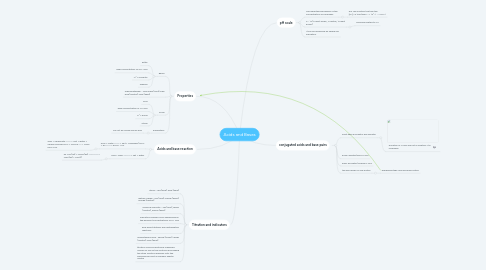Acids and Bases
Door Magnus Drechsler


1. Properties
1.1. Bases
1.1.1. Bitter
1.1.2. high concentration of OH- ions
1.1.3. H^+ acceptor
1.1.4. slippery
1.2. Phenolphthalein - colourless (acid); pale pink (neutral); pink (base)
1.3. Acids
1.3.1. Sour
1.3.2. high concentration of H+ ions
1.3.3. H^+ donor
1.3.4. Sticky
1.4. amphoteric
1.4.1. can act as a base and an acid
2. Acids and base reaction
2.1. Acid + Metal ——-> Salt + Hydrogen (2HCl + Zn ——> ZnCl2 + H2
2.1.1. Acid + Carbonate ——-> Salt + water + Carbon Dioxide 2HCl + CaCO3 —-> Cacl2 H2O CO2
2.2. Acid + base ———> salt + water
2.2.1. ex. HCL(aq) + NaOH(aq) ————> NaCl(aq) + H2O(l)
3. Titration and indicators
3.1. litmus - red (acid); blue (alkali)
3.2. methyl orange - red (acid); yellow (alkali); orange (neutral)
3.3. universal indicator - red (acid), green (neutral), purple (alkali)
3.4. indicators change colour depending on the different concentrations of H+ ions
3.5. acid-base titrations are neutralisation reactions
3.6. Bromothymol Blue - yellow (acidic); green (neutral); blue (alkali)
3.7. titration involves reacting a measured volume of one of the solutions and adding the other solution gradually until the equivalence point is reached; exactly neutral
4. pH scale
4.1. The logarithm expression of the concentration of Hydrogen
4.1.1. E.g. The solution that has the [H+]=0.1mol/dm3 --> 10^-1 --> pH=1
4.2. 0 - 14 (0 most acidic, 7 neutral, 14 least acidic)
4.2.1. inversely related to H+
4.3. It can be measured by several pH indicators.
5. conjugated acids and base pairs
5.1. must have a receptor and donator
5.1.1. donation of H ions are not in isolation; it is reversible
5.2. acids; donate/loose H ions
5.3. base; acceptor/receive H ions
5.4. the pair differs in one proton
5.4.1. depending their acid and base nature
